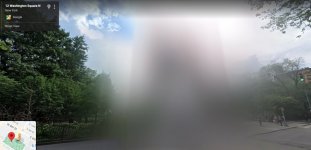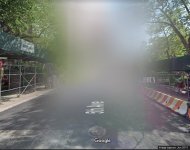So, here's some more highlights from that PDF. First, the NYT article from 1890 during the construction of the arch:
So, throughout the PDF it quotes a few other sources that claim basically that Potter's Field (meaning pre-1825) was used as a burial ground. It implies that it was mostly used for mass burials (of who exactly?), but also says that some of the local churches supposedly used sections of it to bury members of their congregations. Judging by this article, it doesn't appear that was the conventional thinking in 1890, as the digging up "headstones" seemed to throw everyone for a loop. This raises lots of questions, including why would the churches not be horrified when the city decided to just fill in their cemeteries and not relocate the bodies? Also, is it reasonable that this discovery would be shocking a mere 65 years later?
Going on in the PDF, it explains how large segments of the park has been artificially filled and leveled since, well, who knows?
Then there's the widespread idea that the Square was used for executions originally. But where?
Hangman's Elm - Wikipedia.
In 1989, the New York City Department of Parks and Recreation determined that this English Elm was 310 years old. (Currently their website states: "Historical records suggest that it is more than 300 years old."). As a result, many believe that it is the oldest known tree in Manhattan....
...The earliest references to the elm as a "hanging tree" date from the late 19th century, long after the supposed hangings were said to have taken place. Recent extensive research into the park's history by more than one historian has shown that the tree was on a private farm until the land was bought by the city and added to Washington Square in 1827. No public records exist of hangings from this tree.
The only recorded execution in this area was of Rose Butler, in 1820, for arson. She was hanged from a gallows in the city's potter's field, on the eastern side of Minetta Creek, about 500 feet (150 meters) from the elm; at that time, Minetta Creek ran in a shallow ravine between the potter's field and the farm where the elm stood.
So, the oldest tree in Manhattan was moved into its current location and then was called the Hangman's Elm despite it being supposedly moved after executions would have ceased. If there were actually any executions in the Square in the first place!
So... I'm not sure what all of this means, aside from it being a mess. But what we have is a garbled history, evidence of large amounts of land manipulation, unknown underground infrastructure, unclaimed buried bones and an arch with interesting and confusing symbolism with a view of the largest terrorist attack in US history.
I'm gonna need time to digest all of this better. So, I'll leave with these photos for now:
Looks like the "temporary" arch wasn't even at the exact location of the current one.
Wish this was better quality... or that the site that KD linked in the OP was working!



